Freshly squeezed lime juice is one of the absolutely essential cocktail ingredients. But when you're just starting your (home) bartender career, perhaps you wonder whether you really have to squeeze limes for every cocktail.
Perhaps, you can cut a corner, make your life easier, and go and buy your lime juice pre-bottled in the supermarket?
Ultimately, of course, it's up to you. But to help you make up your mind, I will explain everything you need to know about lime juice, its use in cocktails, and how you should use it.
That's a great question. There's quite a large selection of limes, but there are only two different types of limes commonly used for drinks: Persian limes and Key limes.
Persian limes: This is the most common type in the US. It's quite large in size and very juicy. The flavor is not as intense and aromatic as with other lime types, and also it lacks a bit of a sour kick.
Key limes: Key limes are better known as Mexican limes. These fruits are smaller in size and tend to turn slightly yellowish once ripe. They are super aromatic with a tart and slightly floral juice.
Both these limes work great in cocktails, and it really depends on the specific cocktail to give a recommendation on which one to use. For a Margarita, fresh key lime juice works best. After all, they are called Mexican limes for a reason.
Making cocktails is all about balance. To make a great cocktail, you need to get the combination of all different flavors right.
It is much like cooking, where you have to get the right balance of the five primary tastes: sour, sweet, salty, bitter, and umami.
Sourness gets balanced by sweetness. So every cocktail that wants lime juice also has a sweet ingredient. Usually, that is syrup, but a sweet liqueur is an option, too.
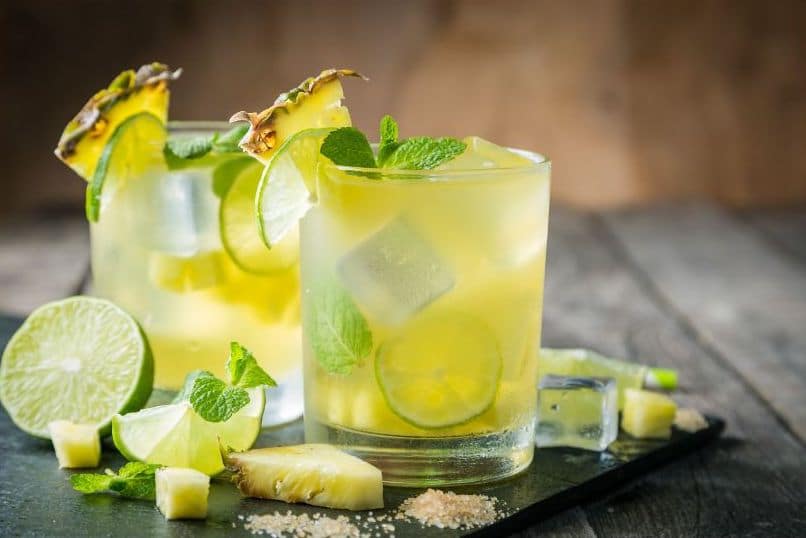
So let's assume you have the lime juice and syrup balanced. Add white Rum to this mix, and you have a Daiquiri cocktail. The combination of sweet and sour covers the harsh alcohol notes of the white Rum and makes a delicious and refreshing drink.
Now you know why you need lime juice -or, alternatively, lemon juice- in your drinks. But does it have to be freshly pressed lime juice, or can you buy those bottled versions from the supermarket?
Let's check out the different options:
Almost every recipe that includes limes specifically asks for fresh lime juice. And making it is super easy. Get fresh limes, cut them in half, and squeeze them.
Using fresh lime juice in a drink adds a tart, acidic bite. This sour kick is also why many bartenders claim that fresh lime juice is the best choice when shaking up a summer cocktail - or any cocktail, actually.
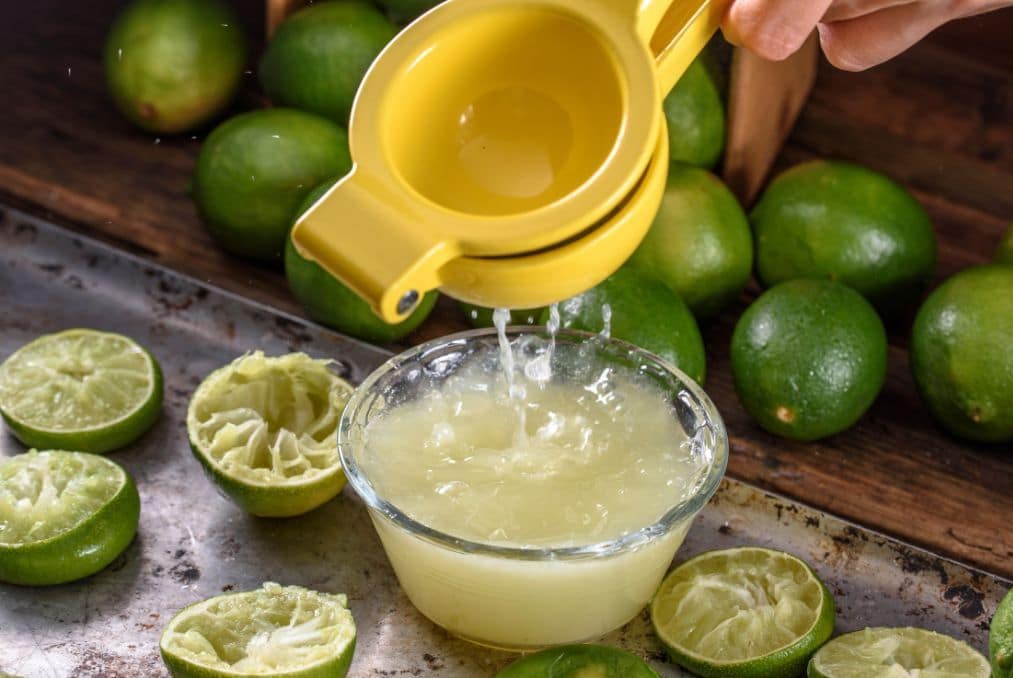
The most basic way to juice a lime is by firmly rolling the lime on a table. This applied pressure makes it a bit easier to extract the juice. Then cut the lime in two halves and squeeze them by hand.
You don't need any tools to make fresh lime juice. Yet, it certainly makes life easier.
So, if you intend to make fresh lime juice often, best order a decent lime squeezer. This nifty tool will save you a ton of time and hassle. Put half a lime in the squeezer - the open side facing down - and firmly squeeze the lime to release the fresh juice.
The amount of lime juice you can get out of one fruit depends on the type. A whole Key lime will usually get you around 30ml (1oz) of pressed juice. One Persian lime, on the other hand, typically contains 1.5oz.
Quickly doing the maths, half a Key lime will contain 15ml (0.5 oz) of juice and half a Persian lime 0.75oz. -I want to mention this explicitly because some recipes solely ask for the juice of half a lime.

You can find bottled lime juice in almost every supermarket, making it a very convenient option. And that is why it gets bought way too often.
Added preservatives and sugar make the lime juice less acidic and turn it into an artificial, sometimes almost flavorless version. Not all bottled lime juice is low quality per se, but you can always taste that it is not fresh.
Thus, it is not in the same league as freshly squeezed lime juice, but it's still an option.
If you really don't want to squeeze limes and make lime juice fresh, there is, in fact, one brand that I know of that produces an alright option: Nellie & Joe’s Famous Key West Lime Juice.
Molly Young from the Strategist swears by it, and I can see why. This bottled lime juice is made from key limes, distinguishing it from competing products in a good way.
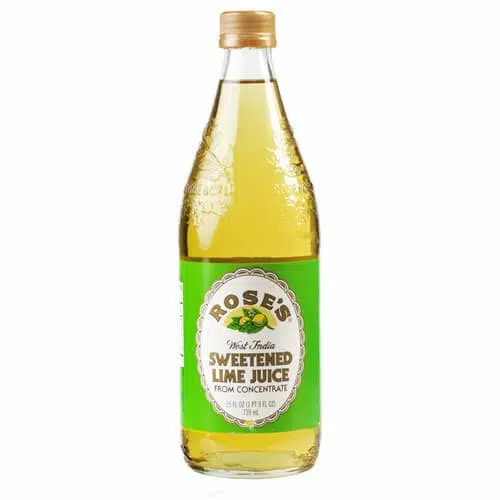
Lime cordial has similar disadvantages as bottled lime juice and then some. Because with lime cordial, the amount of sugar is way higher.
The added preservatives and sometimes even artificial coloring makes it my least favorite option.
However, some cocktail recipes still ask for lime cordial. If, for example, you want to create a quick and dirty version of a Gimlet, use a bit of lime cordial and Gin, and you have a cocktail.
But trust me, whatever you create with cordial or bottled juice will not be as good as it could be.
Freshly pressed lime juice tastes downright acidic. While this sourness is what we're looking for in a cocktail, sometimes aged lime juice will make your cocktail even better. But let me explain.
When you squeeze lime, the cellular structure of the fruit breaks. The enzymes encounter chemical compounds like Nomilin and Limonoate A-ring-lactone, turning them into a bitter-tasting substance called Limonin.
Perhaps you now wonder why one would want to have a bitter-tasting compound in lime juice. Well, Limonin is by no means bitter enough to make the lime juice unpleasant.
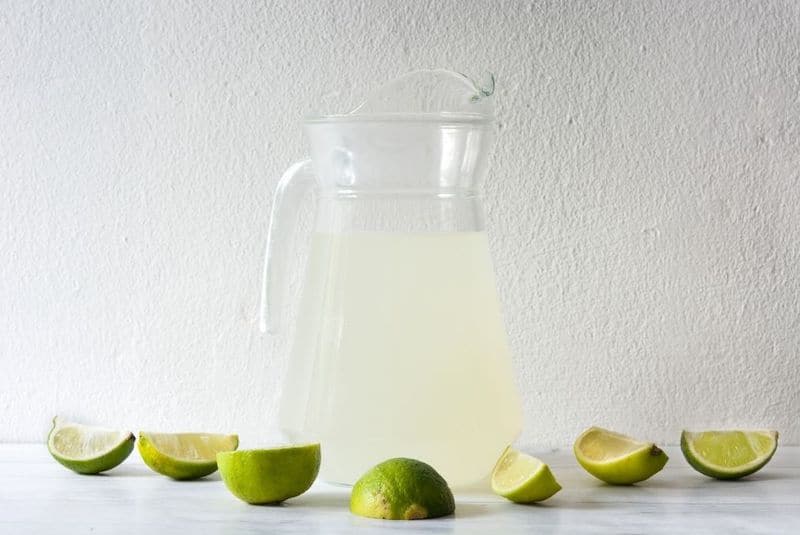
Thus, overall, the juice won't taste bitter, but the Limonin balances some of the harsh acidic notes of fresh lime juice.
As a result, aged lime juice has a way rounder flavor profile. Also, the cocktails you create with it will have a rounder, more mellow taste.
Clarification in cocktails is not a new thing. In many cases, whole drinks are clarified by using milk. Clarified lime juice, though, is a bit different.
Firstly because it's a base ingredient, but more importantly, lime juice is not clarified with milk but with the help of agar-agar (or agar) powder.
The result is a crystal-clear version of lime juice that keeps the tangy taste but looks entirely different. It's a great way to create elegant twists on cocktails, like a Daiquiri or a Margarita.
Mixed drinks made with carbonated ingredients benefit the most from using clarified lime juice, explains Dave Arnold, owner of Booker and Dax, a food and drink research lab in New York, and author of Liquid Intelligence.
He says, regular juices contain many tiny particles that produce bubbles and "Those errant bubble-making particles will wreak havoc in your drink and reduce the level of carbonation you can achieve.”
The best lime juice for cocktails is freshly squeezed, either when preparing a cocktail or in a large batch in advance, and then aged for a few hours.
The latter is what you usually get at cocktail bars. When bartenders and barbacks prepare the ingredients for an evening shift, they will juice limes and lemons and store them separately in easy-to-use squeeze bottles.
That helps to make drinks faster, and in the hours between squeezing and mixing, it will develop a more mellow taste characteristic of aged lime juice.
When a recipe asks for lime juice, you are always better off when you go with the freshly squeezed version. Either use it immediately or let it age for a couple of hours.
But don't be led to believe you can achieve the same result with bottled juice or even cordial. Honestly, these are only good when you are okay with sacrificing quality.
Tanqueray and Beefeater are respected traditional Gin brands. And both of them, Beefeater and Tanqueray, are among the top-selling Gin brands in the world.
While Beefeater ranks at a respectable 4th place, Tanqueray Gin managed to secure the 3rd place. The only Gin brands ranking them out are Bombay and Gordon's.
Beefeater and Tanqueray both are popular options in mixology. Therefore, let's take a closer look at these two.
Let's find out their differences and the strengths and weaknesses of each product. And let's see which one you should choose for which purpose when stocking up your home bar.
Let's start by looking at some hard facts.
| Beefeater Gin | Tanqueray Gin | |
|---|---|---|
| ABV | 40% (44% in US) | 43.1% (47.3% in US) |
| Country | England | Scotland |
| Price per bottle | $20 - $25 (£15 -£18) | $25 - $30 (£18 - £21) |
| Number of Botanicals | 9 | 4 |
| Distillation | Single | Double |
| Introduced | 1876 | 1830 |
| Owner | Pernod Ricard | Diageo |
Having that clear, let's see where the other similarities and differences are.
As mentioned, Tanqueray and Beefeater are London Dry Gins.
London Dry is practically the most traditional type of Gin you can get. -Btw., if you're a bit confused regarding all those terms coming up, I wrote an article explaining the different types of Gin.
But back to the London Dry: among the different types of Gin, it is the one with the strictest rules. Although contrary to what the name suggests, none of these rules is that it has to be from London.
London Dry Gins have to fulfill these regulations:
Plus - but that's not officially required- when sipping London Dry Gins and comparing them to others, you will often notice more prominent notes of juniper.
So now that the basics are covered, let's look at the defining characteristics of Beefeater and Tanqueray.

Tasting Beefeater Gin, you'll be surprised by notes of candied lemon peel, berries, rosemary, cardamom, vanilla, and hints of cloves. Overall it has a fruity, almost sweet finish, which, in fact, is unusual for a London Dry Gin.
Beefeater is a Gin you can use for various purposes. You can drink it neat and it works in a classic juniper forward Gin and Tonic, but it is an even better choice for mixing cocktails.
In my opinion, the flavor of Beefeater often get a little lost when mixing it, which is fine in Gin cocktails but not ideal in a G&T.
Nose: Overall, the nose is quite subtle but very fruity with notes of lemon zest, fresh apple, juniper, and hints of vanilla.
Palate: Dominated by candied lemon and sweet juniper. Subtle notes of vanilla, coriander, and hints of cloves.
Finish: Quite subtle but long and fruity finish. It is somewhat on the sweet side.
Beefeater Gin uses a single distillation process.
Before that, the botanicals infuse in a 24-hour steeping process. The steeping allows extracting the maximum amount of flavor of the nine botanicals.
According to Beefeater, the following botanicals are in the Gin:

Tanqueray is quite famous for its distinct taste of juniper.
The piney juniper-forward taste is indeed the most outstanding characteristic of the Gin. There are hints of citrus as well as angelica and licorice.
It is a classic Gin that works exceptionally well in a Gin and Tonic. For me, it's one of the best choices if you're looking for an affordable Gin to create some G&Ts.
However, the dominant and intense taste of Tanqueray can sometimes be overpowering for some cocktail recipes.
Nose: Piney juniper notes, intriguing hints of lemon zest, and angelica.
Palate: Strong notes of juniper are complemented by angelica root and coriander seed.
Finish: The finish is quite long, dry, and warm.
Tanqueray Gin uses a double distillation process.
The botanicals are added in the second distillation step. One of the reasons for its distinct juniper taste is that it uses only four different botanicals.
Those botanicals are:
Doubtlessly, Tanqueray and Beefeater are two quality Gins. Both are versatile and have slight advantages in different fields.
If you're looking for a Gin to make some Gin and Tonic, I would recommend Tanqueray.
If you're looking for a Gin to create cocktails, Beefeater should be your first choice.
Either way, with both, you're getting a quality spirit for little money.
Tanqueray and Beefeater are not the only two gins that are often discussed. Here are some more comparisons of popular gin brands, showing how they compare against each other.
When making an Old Fashioned cocktail, Angostura bitters are an indispensable flavoring ingredient for every bartender. Just one dash of bitters can change the taste of a drink and enhance the flavor profile. The small bottle with the bright yellow cap and the oversized white label is a product with an intriguing history. intense
Aromatic bitters have an intense, concentrated taste. Their predominant purpose is to deepen the flavor profile of cocktails. But where did they come from? Who invented the bitters? And why is the Angostura bitters label way too big for the bottle? Learn more about the origin of one of the most substantial cocktail ingredients.
The inventor of the famous Angostura Bitters is Dr. Johann Gottlieb Benjamin Siegert from Germany. He moved to the town of Angostura (today Ciudad Bolivar) in Venezuela, developing a formula for a medical tonic while working as surgeon general for Venezuelan military leader Simón Bolívar. Already by 1824, he had perfected the recipe for the "Amargo Aromatico" - Spanish for aromatic bitters.
Dr. Siegert created this mixture of water, alcohol, local herbs, and spices as a medical tonic for Bolívar's army. It was supposed to cure the upset stomachs of soldiers, and their original name was Dr. Siegerts Aromatic Bitters. Later it was named after the Venezuelan city of Angostura (now Ciudad Bolívar), where Siegert once lived.
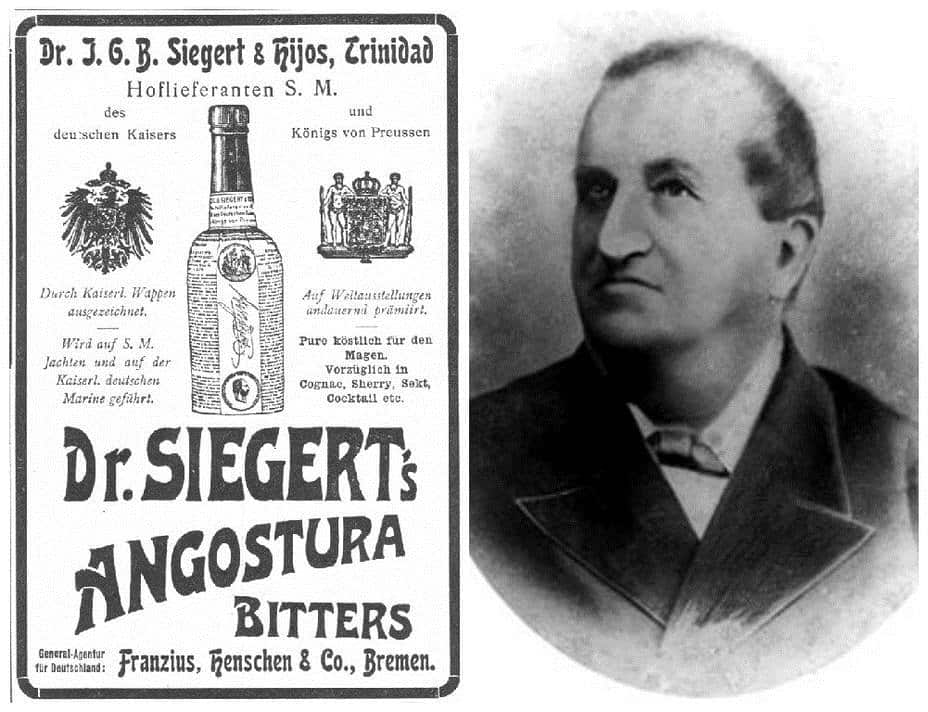
In 1830, only six years after he finished the recipe for Angostura bitters, Siegert established a distillery in Venezuela to produce them. It took another 23 years until 1853 to export Angostura bitters and sell them abroad.
In England, this led to the famous Pink Gin, a pink cocktail created by a bartender adding a dash of Angostura bitters to Plymouth Gin. However, the combination of alcoholic beverages and bitters was not new. First came the Old Fashioned cocktail with Stoughton's bitters - a medical tonic invented in England in the early 1700s.
Still, Dr. Siegerts Aromatic Bitters were, and still are, different. Their secret recipe, including over 40 botanicals, created an unparalleled complex and bittersweet flavor profile.
The "Weltausstellung" in 1873, a world's fair held in Vienna, was the next step to international fame. There, it won the "Medal of Excellence," still depicted on the oversized label on the bottle of Angostura bitters.

In 1876, only three years later, they won another gold medal at the World Trade Fair held in Philadelphia. These two awards paved the way for the victory march of the famous aromatic bitters.
Of course, the invention of more classic cocktail recipes using these bitters in their recipe also contributed to the success. One of them is the Manhattan cocktail, invented in 1874.
After Dr. Siegert died in 1870, his sons Carlos, Alfredo, and Luis Siegert took over and relocated the business to Trinidad & Tobago. It was, by the way, also his sons who brought the bitters to the World Trade Fairs in 1873 and 1876, winning said medals.
Also, the famous bottle design with the too-big label came from their reign and stuck with the brand until today. Further, they brought the bitters to (back then) remote places like Australia, where it influenced Australia's national drink - a concoction of lemon, lime, and Ango bitters.
In 1903 Carlos Siegert died, leaving his two younger brothers, Luis and Alfredo, the owners of the secret formula and the company. Changes followed quickly, and in 1904 the company was renamed Amargo de Angostura. [1]
Also, Alfredo was announced as the royal purveyor of Angostura bitters for Prussia (1904), Spain (1907), and King George V of England (1910). In 1912, he even went public as a registered company in England. And after his brother Luis died in 1905, he was the sole person responsible for the business.
In 1921, the Angostura Bitters (Dr. J G B Siegert & Sons) Ltd was formed. Consequently, the company name changed to Angostura Limited. [2]
The look of the Angostura bitters bottle is quite unique: A bright yellow bottle cap and a large white label are the signature packaging. In fact, the oversized label is one of the most confusing things about aromatic bitters. Why is it so big?
It looks and feels like a marketing stunt. But it's most likely one of the best examples of miscommunication - despite the positive outcome.
When Dr. Siegert's sons joined the family business, they intended to enter a competition with their father's bitters. In preparation for said competition, they wanted to develop new packaging for the bitters. -A new bottle design in combination with a new label.

To save time, they split the tasks to get labels and bottles between them. But they forgot to discuss the exact measurements of said item. When they finally met again to bring both parts together, they realized their mistake: label and bottle sizes were not matching; -At all.
There was no time to do anything about it, so they entered the competition regardless - and lost! Still, for reasons unknown, they decided to stick with the packaging.
In the end, that decision paid off, as it made people remember the bottle as well as the brand, eventually accelerating their success. However, there are rumors that Alfredo wasn't so lucky with all his business decisions.
It's said that some of Alfredo's speculations and business decisions failed and that he lost enormous amounts of money. It's even indicated that Angostura bitters were handed over to its creditors due to this development.
However, it's hard to find quality sources for the true history. The only sources I could find confirming this story don't mention details like dates or names of creditors.
The best of these sources is probably the book "Bitters: A Spirited History of a Classic Cure-All by Brad Thomas Parsons. The said passage from the book reads:

The classic version of aromatic bitters is still the most important product made by Angostura Limited. But today, the Angostura distillery in Port of Spain, Trinidad also produces Rum, including some premium bottles, soft drinks, and other bitters.
In 2007, they launched Angostura Orange bitters. As the name indicates, they combine complex orange flavors with their signature spices. Another thirteen years later, in 2020, Angostura released their third type of bitters - the Angostura Cocoa bitters.
In 2009, there was some media hype due to a shortage of renowned bitters. Many newspapers and bloggers suspected a production halt in Trinidad or product recalls. Later it turned out that Angostura indeed had to stop production as they had run into a shortage of ingredients.
The simple yet elegant mix of very few ingredients makes the classic Manhattan Cocktail delicious and easy to mix. Its base is Bourbon or Rye Whiskey and Sweet Vermouth, bound together by a few drops of cocktail bitters.
The flavor profile is appealing to novices and seasoned drinkers alike. The vermouth adds a subtle sweetness and deep flavors, which work great with rye and bourbon.
So, here's the history of this somewhat underrated Manhattan Cocktail. Read where it originated, who invented it, and how it got its name.
Most likely the Manhattan cocktail was invented in the 1860s by a bartender named Black, who created the drink while working at a bar on Houston Street on Broadway, New York.
However, there are many versions of the history of the invention of the Manhattan cocktail. What is certain is that it dates back to the mid-1800s and has been one of the first - if not the first- cocktails to include sweet vermouth.
As with most vintage classic cocktails, it is hard to tell who mixed them first. However, of the many claims and tales, two stories stand out. -One a little more glamorous, the other, according to historians, more credible.
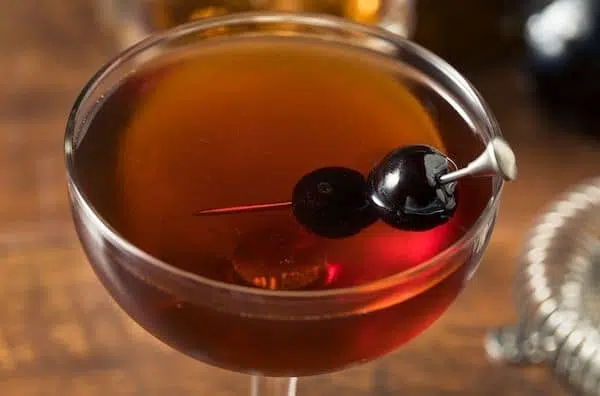
The first story conveys that the Manhattan cocktail originates from the Manhattan Club in New York City. For a long time, newspapers and blogs took that at face value. However, eventually, it turned out that the foundation is weak, not to say non-existent.
The club explained that the drink had been a creation for a party held in late 1874 by Lady Randolph Churchill for presidential candidate S.J. Tilden. -Churchill, as in Winston Churchill's mother.
That claim was supported in a newspaper column by Patrick Murphy in March 1945. He wrote that there had been a memorable party on the evening of December 29th at the Manhattan Club in honor of Samuel J. Tilden.
According to Murphy, a drink made of „American Whiskey, Italian Vermouth, and Angostura Bitters" preceded said dinner. However, he also pointed out that one should remain dubious, as it may well be that the drink had been served before already.
Since Lady Randolph was not even in the US in December 1874, the rest of the story may well be made up either. She had given birth to Winston Churchill just four weeks before the alleged dinner and spent some time in France. - And even if that party had taken place and Manhattans had been served, that would not mean the cocktail wasn't invented before.
The more likely version, according to historians, is the story of Mr. William F. Mulhall. He had been a respected bartender working at Hoffman House in New York City at his time.
In the 1880s, Mulhall wrote a story in Valentine's Manual that included the claim that the Manhattan cocktail had been invented by another bartender named George Black in the 1860s (check here):
"The Manhattan cocktail was invented by a man named Black, who kept a place ten doors below Houston Street on Broadway in the [eighteen-] sixties—probably the most famous drink in the world in its time."
William F. Mulhall
However, Mulhall making this claim almost 20 years after the event has made many people doubt his story.
On the other hand, there seems to be no motive why William F. Mulhall would have made this up. After all, he had and has no benefit by claiming this.
The Manhattan Club argues that the name of the cocktail is associated with them. Yet, it does not seem likely that the club was involved in creating the drink. Instead, as you might have guessed, it simply was named after the most famous New York Borough, Manhattan.
Nowadays, you can also find recipes and cocktails for the other four boroughs: Bronx, Brooklyn, Queens, and even Staten Island. They are not equally recognized and influential, but they all play a role in modern mixology.
The Manhattan cocktail recipe certainly is an intriguing one. -More so because it was subject to constant change and updates.
Whiskey, Vermouth, and cocktail bitters are the main components. But ratios changed over time, and so did some extra ingredients. The most popular additions were drops of gum syrup, Curacao, or even Absinthe, like in the recipe from the Flowing Bowl below from 1892.
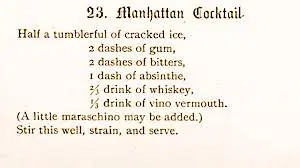
In the 1900s, the recipe changed once more. Gum syrup and Absinthe were removed from the recipe, and Angostura bitters replaced orange bitters.
Canadian Whiskey took over the lead in the Manhattan Cocktail as it was easier to get your hands on during prohibition. Even in the post-prohibition era, many used Canadian Whiskey for its smooth taste. Over time the Whiskey choice changed to bourbon, and then back to wye Whiskey again.

The typical bourbon flavor profile works well with the rich and sweet taste of Vermouth, but it creates a comparably sweet drink. That is one reason the classic Manhattan cocktail recipe uses rye whiskey as a base. Another reason is that rye was most likely the whiskey used originally.
Although there are only three ingredients, there are many variations and riffs on the classic recipe. Not as many as for an Old Fashioned, but still plenty. I won't cover them all but focus on four variations I want to explain here.
One popular riff on the Manhattan cocktail is called Black Manhattan. This twist swaps in Amaro Averna instead of sweet Vermouth.
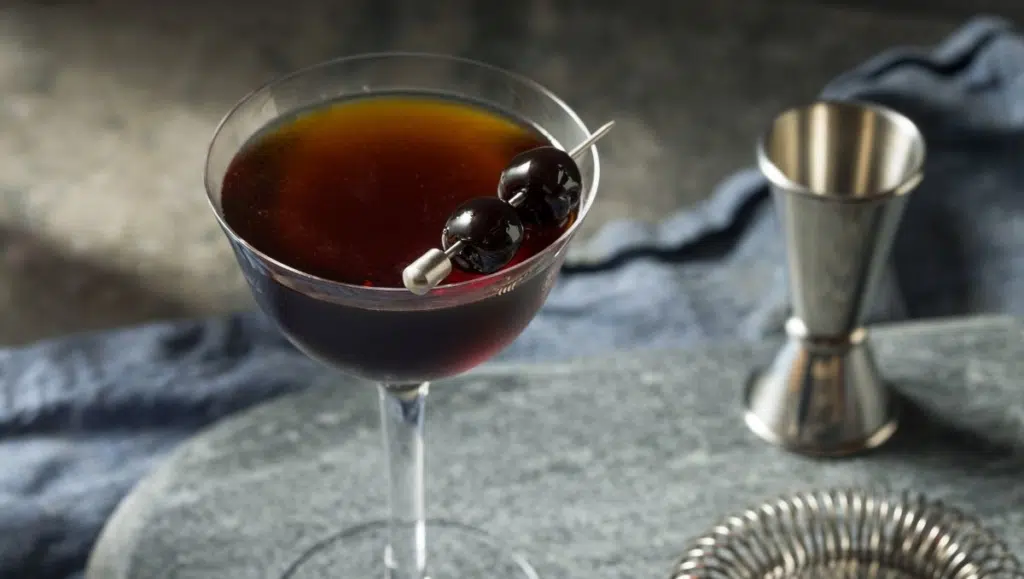
The result is a more aromatic cocktail compared to the traditional Manhattan recipe. If you don't have a bottle of this Averna at home, maybe you find a great alternative to Amaro Averna here.
As the name indicates, the main difference is in the Whiskey part. Also invented in Manhattan, in the Waldorf Astoria Hotel, this Manhattan uses Scotch Whisky instead of Rye or Bourbon.
The Dry Manhattan substitutes the vermouth art of the drink. Instead of Sweet Vermouth, it contains Dry Vermouth. The resulting drink is far less sweet and focuses more on the herbal and bitter notes of the cocktail.
For making a perfect Manhattan, the Vermouth part gets split. A mix of 50 percent Sweet Vermouth and 50 percent Dry Vermouth creates a perfect balance. Tastewise, the difference from the classic is identifiable but subtle to people new to the cocktail. Though, if you drink Manhattan cocktails regularly, you will notice that the drink is less sweet than your usual Manhattan.

If you're a bartender working in a cocktail bar, you have the luxury of being surrounded by an abundance of beautiful and fancy liquids far beyond the cocktail essentials.
Your home bar, on the contrary, probably is not stocked that well. And I'll tell you something: it doesn't need to be. You don't have to buy thousand different things to serve delicious cocktails.
Yet, having some key cocktail ingredients will make your cocktail-creating life a lot easier. And I will explain what you really should have in your home bar.
Many famous cocktails don't require many different ingredients. And many of them even are pretty standard. - You're not so sure about that? Check this list of the ten most popular cocktails in 2020 according to drinksint.com:
Each can be made with four ingredients max. So, you don't need a lot of things. You only need a cocktail shaker, mixing glass, jigger, and the right ingredients. Thus, I will show you how to make the most out of your home bar by stocking your bar cart with essential cocktail ingredients.
Jump to Spirits | Liqueur | Vermouth | Bitters | Syrup | Citrus | Other Juices | Ice | Mixers | Garnish
To make great drinks in your home bar you need a well-balanced selection of quality base spirits. To cover most of the classics, you only need six different types of liquor:
Picking the best bottles isn't easy for beginners. It requires a certain level of experience or research at the beginning of your cocktail-making journey. But we're here to help:
Whiskey is an essential base spirit. It's key to classics like the Old Fashioned, Manhattan, and Whiskey Sour. But there's a large variety within that category: Bourbon, Rye whiskey, Scotch, etc., all have a distinct taste.
Also, cocktail recipes sometimes ask for specific types of Whiskey. So which one to choose?
Our Recommendation: Pick one decent bottle of Bourbon and Rye. If you're really into Whiskey, you can add a bottle of Scotch or Irish Whiskey to the list. The latter two are a bonus, though, because you can most Whiskey drinks with Bourbon or Rye.
Buy:

Vodka is one of the most popular spirits in the US, especially in cocktails. It is colorless and has a relatively neutral taste, making it a perfect fit for many recipes.
It is part of countless favored cocktails recipes like an Espresso Martini, Bloody Mary, Moscow Mule, or Cosmopolitan.
Our Recommendation: You can get quality Vodka at a comparably low price. So we recommend going with one of the mid-shelf bottles.
Buy:
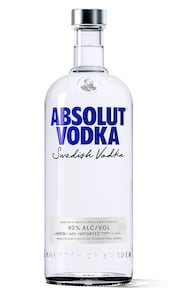
Rum is another must in a home bar. I advise getting one white and one aged, dark Rum. Light ones are perfect for Mojito's, and dark ones are the base for all beautiful Tiki cocktails and other sweeter creations.
Besides those, there are many other Rum types like spiced Rum, Cachaça, Rhum, etc. These are great in some cocktails, but it's not what you should stock up on at the beginning. These are for later mixing adventures.
Our Recommendation: Get a Plantation 3 Stars for your white rum. This bottle is one of the best you can get, and it sells for under $20. The dark version should be versatile, so it works in many drinks.
Buy:
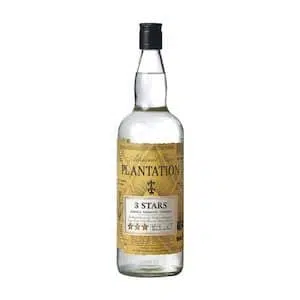
With so many types of Gin, choosing just one Gin for your home bar is a challenge. I have to say, my shelves at home are packed with Gin of all sorts.
But when you start your home bar, you want to keep things simple, affordable, yet versatile. Hence, I only suggest getting only one for a start.
Our Recommendation: Go with a traditional, quality Dry Gin. One that works great in a classic Gin and Tonic and other top Gin cocktails, too. My recommendation here is Tanqueray, Beefeater, or Sipsmith London Dry.
Buy:

Although there are plenty of Tequila types to choose from, you only need one quality Tequila Blanco or Reposado in your home bar, at least for now.
If you're into smoky flavors in spirits, I recommend adding a Mezcal to your selection. If you want to know the difference, here's a comparison of Tequila and Mezcal.
Our Recommendation: Depending on your budget, I recommend an affordable Tequila Blanco or Reposado. If you want one of the best, choose Fortaleza Blanco.
Buy:

Brandy is part of the six base Liquors but is used a lot less in cocktails. If you want to skip one, usually, that would be it.
Nevertheless, you can make good drinks with a Brandy base, and if it fits your budget, get one to make your base liquor selection complete.
Our Recommendation: Look for a VS or VSOP Cognac to get a decent-quality bottle.
Buy:

Liqueurs play a vital role in mixology. You need those sweet and tasty elements to bring flavor to your drinks. However, liqueurs are available in almost every taste imaginable. The main categories are:
Luckily you don't need each and every liqueur there is. In the beginning, I suggest sticking with the most-used options. These so-called essential liqueurs are:
That's it for a start. Five elemental liqueurs I recommend having in your home bar.
Of course, there are many more, from Elderflower Liqueur to Midori Melon Liqueur, different Crèmes. I could go on forever. If you're interested, check out our Liqueur section.
I list Vermouth separately because it is not a liqueur but a fortified wine. Also, Vermouth is an integral part of many recipes. For instance, sweet Vermouth is necessary for a Manhattan or Negroni. Dry Vermouth is crucial in a Martini.
Plenty of other classic cocktail recipes call for one of those two. Sometimes even for both. Therefore, I strongly advise getting one bottle each. You won't regret it.
If you can only buy one, though, go for Sweet Vermouth. You'll be able to make a wider variety of drinks with it.
Buy:

For me, the critical ingredient on this list. Overlooked by many aspiring home bartenders, cocktail bitters are an absolute must. They are part of dozens of classic cocktail recipes, but because you always only need a few drops, people tend to think they are negligible. Oh, how wrong that is!
Cocktail bitters are highly concentrated infusions, and a few drops are enough to alter the taste of your cocktail significantly. They are available in various flavors, but for starting your home bar, I recommend beginning with just one: Angostura bitters - the best-known and most common ones.
Once you want to experiment with how bitters can affect the taste of drinks. Experiment with other classics like Peychaud's bitters or some decent orange bitters before having a look at these articles:
Sweet syrups are another essential cocktail ingredient you should have. Many cocktails which don't use other sweet ingredients rely on simple syrup to balance sweet and sour.
Just think of delicious Sour cocktails like the Whiskey Sour, Rum Sour, or Gin Sour. For all of these recipes, you will need syrup to mix them at home.
The best part is: you can make all sorts of syrup at home for very little money. Simple syrup is essential. Everything else is extra. You haven't made syrup before? Here's our simple syrup recipe.
If you want something fancier or richer, consider making your own Gomme or Demerara syrup or a color-changing Butterfly Pea syrup.
Lime juice and lemon juice are indispensable for most cocktails. They balance the sweetness from syrup, liqueurs, or Vermouth. You really need that tangy and sour citrus juice.
I often see people working bottled juice from concentrate for their home bar. But that is a big No-No and has a massive impact on the result - and not in a good way.
When freshly squeezed those lemons and limes, your cocktails taste far better. That is such a simple way to improve the quality of homemade cocktails.
When it comes to making drinks at home, fruit juices are essential for adding freshness and vibrant flavors to your cocktails. Besides lime and lemon juice, consider having the following juices in your arsenal:
These versatile fruit juices will bring flavor to your homemade cocktails, impressing friends and family alike.
Ice is vital for your drinks. The quality and form have a huge impact when mixing your cocktails. Ice used in cocktails is also available in different shapes and sizes.
The larger and clearer the ice is, the better its quality because impurities make your ice melt faster. Quality ice will melt slower and, therefore, won't dilute your cocktail as much.
If you pulled it off and made some crystal clear ice cubes, you can consider branding them. An ice stamp embosses a motive or name on an ice cube within seconds. -Which is, naturally, not essential, but still a nice gimmick.
Mixers are vital for Highballs, Spritzes, or fizzy cocktails like an Americano or one of the Collins Cocktails. It's always a good idea to have tonic water, soda water, ginger beer, ginger ale, and Coke at home.
For soda, a quality club soda will do, tonic water can be tricky, but as a base, I recommend Fevertree Indian and/or Fevertree Mediterranean tonic water. And for the Coke, I prefer the one with the ice bears.
Cocktail garnish is less important than the other items listed, but you should not neglect it. Generally, cocktail garnishes improve the look of a cocktail but don't have a gigantic impact flavor-wise. But there are exceptions, for instance, the salt for the Margarita and the like.
My most used items for cocktail garnish are citrus peels, which you usually will have left from the juices you squeezed out of them.
More creative ideas can be to use flowers as a garnish or try your skills with dusting your cocktail glasses. However, that's the next step on your home bartending journey and not something you have to worry about too much when getting your cocktail essentials.
Here's a quick overview of popular cocktail garnishes:
So that's my list of essential ingredients to make cocktails at home. It may look a little extensive at first, but when writing your shopping list, you will realize it's not too much. If you're a fan of frothy tops on cocktails, also put eggs on the list. Egg whites are traditionally used in Gin Fizz, Whiskey Sour, and similar drinks to get those frothy tops. If you're on a vegan diet, you can use aquafaba instead.
When in doubt, skip a bottle and only buy it once a recipe you want to make calls for it.
Only three ingredients make the Daiquiri cocktail one of the most famous Rum drinks. The elements of a classic Daiquiri are Rum from Cuba, sugar, and lime juice.
The origin of the Daiquiri cocktail lies in Cuba. In fact, the cocktail is named after the small village named Daiquirí which is located just 14 miles east of Santiago de Cuba. Jennings Stockton Cox, an American engineer who was assigned to iron mines nearby the settlement soon after the American-Spanish War, is said to have created the beverage here.
Nowadays, there are plenty of variations of this classic cocktail. Most of them add different types of fruits to it.
The Strawberry Daiquiri, for instance, is highly popular, even though many bartenders are not too fond of it. I have to admit, it is nothing like a classic Daiquiri, but it's a delicious summer cocktail.
You only need three simple ingredients for a Daiquiri: Rum, lime juice, and simple syrup. However, I like to add a few drops of Angostura bitters for a little more depth of flavor.
The type of Rum should be white and unaged - ideally from Cuba, like Havana Club 3 years. If you can't get that, the Puerto Rican Havana Club works, too. For other fantastic options, refer to this guide to the best Rums for making a Daiquiri.
Further, the lime juice needs to be freshly squeezed to get the perfect Daiquiri. Apart from that, you can hardly go wrong with this simple and straightforward recipe.
Although hard to prove, most historians agree that Jennings Stockton Cox is the creator of the Daiquiri Cocktail recipe. Jennings was an engineer from the US, coming to the mines of Daiquiri shortly after the American-Spanish War.
The Americans won over the Spanish, and soon Roosevelt began exploiting the iron mines in Cuba. Jennings Cox was leading one of the initial exploring parties. -The one that took over the mine in the small town of Daiquiri.
At that time, expatriate workers from the US were offered huge salaries alongside monthly rations of tobacco and local Rum. Some of the Bacardi Blanco they received was mixed with sugar cane juice or coffee by the Cuban workers. When Jennings saw this, he began to experiment himself.
There is no documentation on when and how the first Daiquiri got served. However, the granddaughter of Jennings Cox claims that Jennings ran out of Gin when American guests came to visit him. So he mixed a drink with what was available: Rum, lime juice, and sugar.
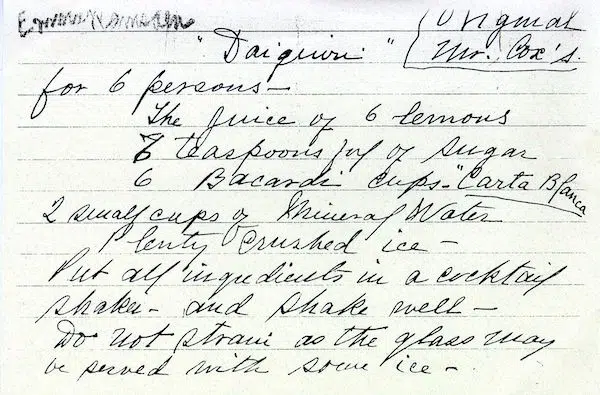
The original recipe is available in handwritten form, declaring to use the juice of 6 lemons, 6 cups of Bacardi Blanco, six teaspoons of sugar, two small cups of mineral water, and loads of crushed ice".
After this event, the Daiquiri recipe remained in Cuba for a while. For one, the city of Daiquiri fought the plague. But also because another cocktail came up in Cuba around the same time. And it took America by storm.
You might have guessed already I am talking about the famous Cuba Libre.
Ultimately, it took about ten years until the Daiquiri cocktail made it to America, thanks to Captain Lucius W. Johnson.
With his ship USS Minnesota, he sailed to Cuba, intending to visit war sites of the American-Cuban War. During the journey, Johnson also visited the small town of Daiquiri.
Jennings Cox was still there, leading the exploitation of the iron mines. When Johnson arrived, he served his creation. Lucius Johnson loved it and took the formula with him to the US, to the Army and Navy club.
That was the first place the Daiquiri cocktail was mixed in the US. For this reason, some sources claim that Johnson invented the drink. Others even suggest that it was an invention by Navy soldiers. The latter, however, is the most unlikely as there was strictly no alcohol allowed on Navy ships.
Allegedly, Johnson himself described his first encounter with the Daiquiri remembering the ratios Jennings Cox used to make the drink. The following statement got published in the Baltimore Sun newspaper:
'He mixed in each glass a jigger of rum, the juice of half a lime, and a teaspoonful of sugar. He then filled the glass with finely shaved ice and stirred it well. In that hot, humid weather, the ice melted rapidly, and the glass quickly became frosted.'
Lucius W. Johnson
In any case, Lucius Johnson did a great job promoting the Daiquiri cocktail in the US. He also introduced it to the Baltimore University Club, which resulted in a Daiquiri version with bitters. A valid variation on the classic Daiquiri cocktail also today.
Slowly more and more bars picked up the recipe and started to serve the Daiquiri cocktail. Even one of the most prestigious hotels in the world at that time had it on their menu in the 1910s - the Astor Hotel in New York City.
Two of the most famous writers of this era made the Daiquiri a worldwide success.
The first one is rarely even mentioned when talking about the history of the Daiquiri. His name was F. Scott Fitzgerald. He was the first to name the Daiquiri in a Novel: in This Side of Paradise, published in 1920.
The second writer makes you instantly think of countless other spirits, cocktails, and bars around the globe: Ernest Hemingway.
He had an enormous impact on the success of the Daiquiri cocktail. He even created his very own variation of the drink, the Papa Doble. Doble stands for double the amount of Rum, and since Hemingway had diabetes, he replaced the sugar with a mix of grapefruit juice and Maraschino liqueur.
Hemingway liked to sip his Daiquiris in El Floridita, Havana. At another bar in Havana, the Bodeguita del Medio, he even left anote on the wall saying: "My mojito in La Bodeguita, My Daiquiri in El Floridita.”
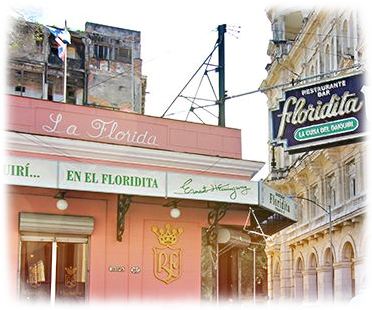
As substantial as the impact of those writers was, mentions in important cocktail books contributed still more to the success of the Daiquiri cocktail. Some of the most influential references are:
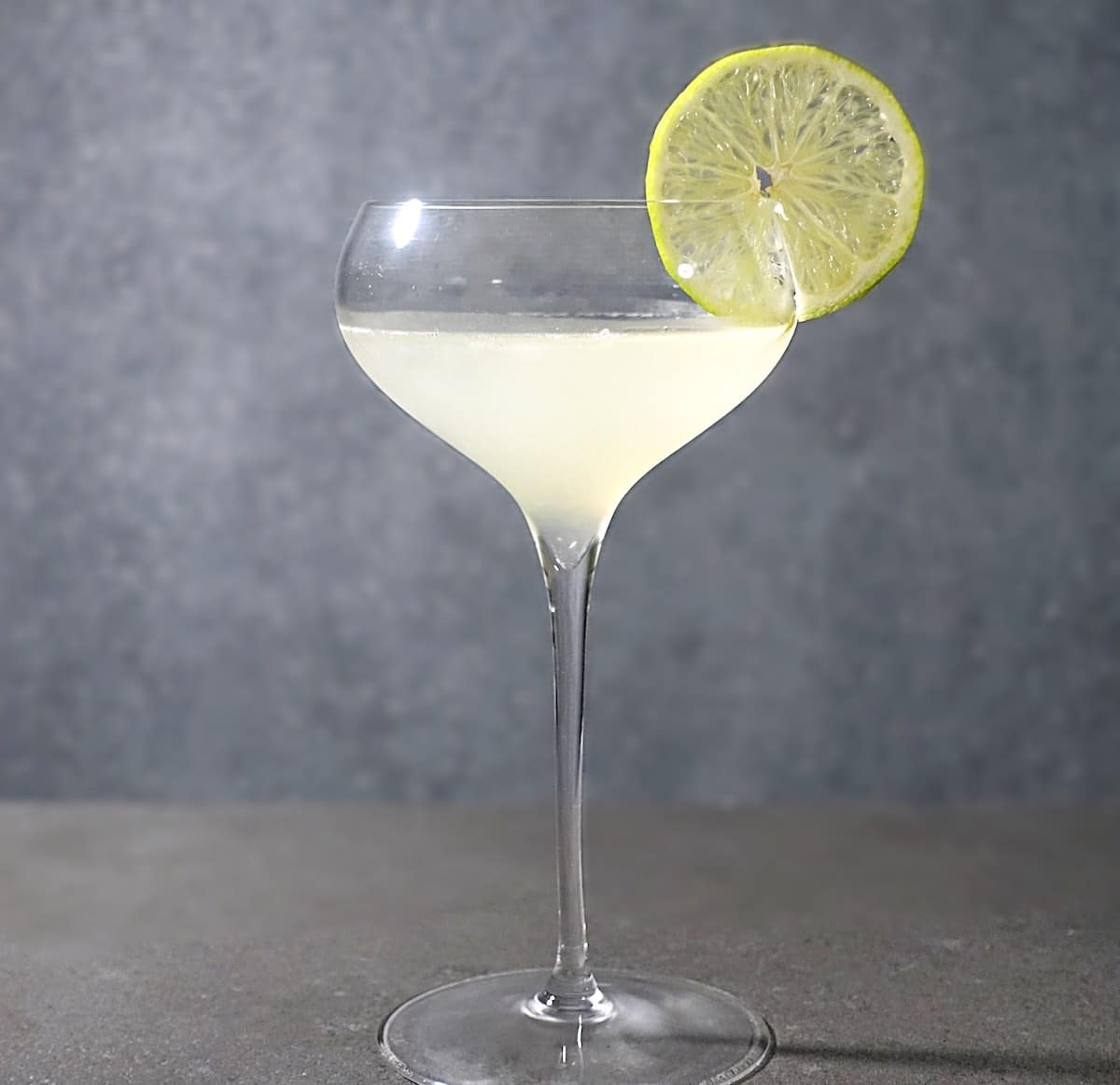
The Strawberry Daiquiri is made of fresh and sweet strawberries, tangy lime juice, and a good portion of Rum.
However, many bartenders are not a big fan of this cocktail because its reputation suffered during the 80s and 90s.
Back then, Strawberry Daiquiris almost always were served with artificial flavorings and coloring: bright neon red slushies that never even have seen strawberries from afar.
And as you can imagine, these party brews were not very enjoyable, indeed. But if properly made, the Strawberry Daiquiri is a real treat.
In contrast to the classic Daiquiri, the Strawberry version, typically, is served frozen.
For this frozen Strawberry Daiquiri, you combine all ingredients and blend them until they have the right consistency. The result is a smooth and icy cocktail reminiscent of a fresh fruit smoothie.
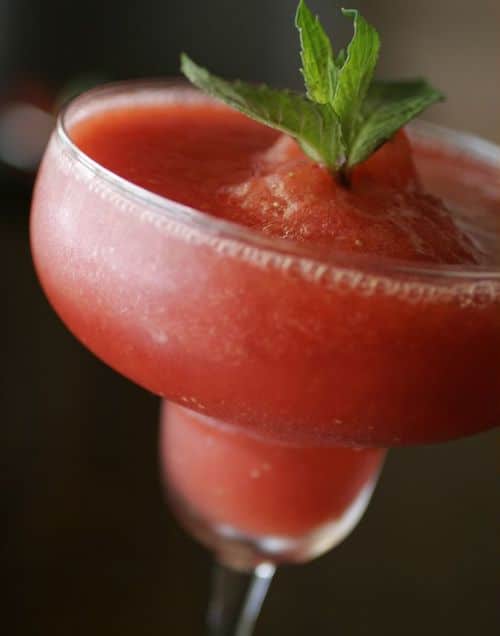
The kick from the Rum is just a bonus and makes this drink an ideal mate on poolside vacations.
And there is also Strawberry Daiquiri which is not frozen and can be made without a blender.
For this not-frozen version, you have to muddle the strawberries together with the simple syrup. Then put all ingredients in a cocktail shaker and carefully strain the drink into a cocktail glass.
Ultimately, there is no actual wrong or right Rum for this fruity Daiquiri twist. Yet, when choosing the Rum for your Strawberry Daiquiri, make sure you take one that doesn't overpower the delicate strawberry taste.
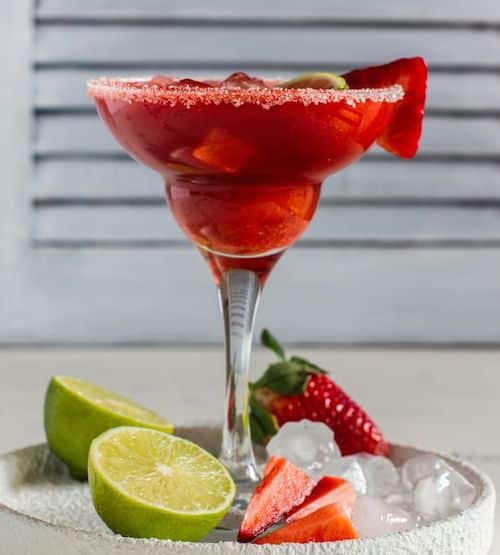
I find white unaged Rum or one that's only slightly aged ideal for this cocktail. But you can try many different Rums.
If you want to stay classic, use a Bacardi Blanco. If you feel like experimenting a bit, try a Jamaican or a French-style Rum. Or you can even consider a coconut-flavored Rum like the ones from Mahiki or Bacardi.
If you want to create a non-alcoholic version of this delicious cocktail, simply use the recipe for the frozen Strawberry Daiquiri and leave out the Rum.
And when you replace the Rum with tonic water, the Virgin version will taste even better. Some recipes suggest sprite as a replacement, but that will result in a super sweet drink. - Way too sweet for my liking.
So if you're serving it to kids, they might prefer the sprite version. When your guests are adults-only, I recommend going with tonic water as a substitute.
Let's take a look at the recipe for the frozen version. As mentioned, we need fresh strawberries and the classic Daiquiri ingredients like Rum, lime juice, and sugar (in our case simple syrup).
To make the Strawberry Daiquiri frozen, we also need ice cubes. I like to use frozen strawberries as a substitute for at least half of the ice cubes.
That way, the strawberry taste is more pronounced, which makes the whole drink taste fresher.
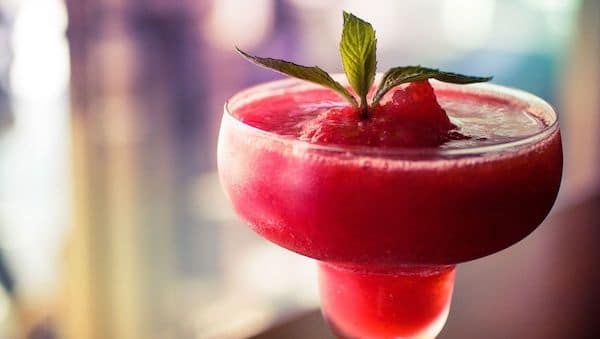
Not everyone is a big fan of frozen cocktails. Therefore, I also have a recipe for the muddled version.
When making a Strawberry Daiquiri that is not frozen, ensure to double strain it to remove any strawberry bits that didn't get fully muddled.
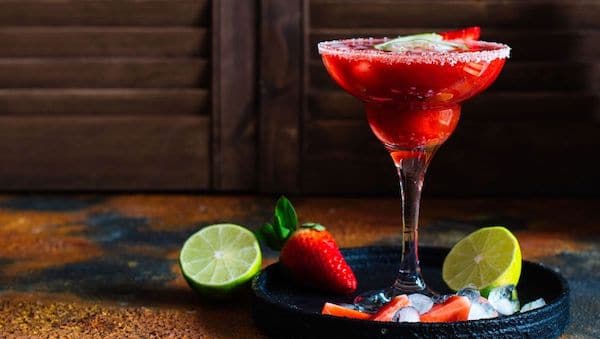
If you like fruity twists on classics, try the frozen Mango Margarita, or the unfrozen version, the Mango Margarita on the rocks.
Another delicious drink is the Painkiller, which adds fresh orange juice to the tropical Piña Colada.
If you're new to whiskey cocktails the Manhattan and Old Fashioned cocktails may look quite similar. Both are three-ingredient whiskey cocktails, were invented in the 1800s, and use Angostura bitters for added complexity. Also, both cocktails put the whiskey base in the limelight - whether that's rye or bourbon.
The main difference between the Manhattan and the Old Fashioned Cocktail is the sweetener. The latter is traditionally sweetened with a sugar cube or simple syrup, whereas the Manhattan uses sweet vermouth; -a sweet, fortified wine from Italy. That leads to a more complex flavor in the Manhattan cocktail with a more subtle sweet note.
Here is a vivid illustration showing where Manhattan and Old Fashioned differ besides.

To get a better overview of how the Manhattan and Old Fashioned cocktails compare, we created the nifty fact table below. As you can see, against popular belief, the Old Fashioned is a stiffer drink than the Manhattan, at least regarding alcohol by volume.
| Manhattan | Old Fashioned | |
|---|---|---|
| Cocktail volume before stirring | 3.063 ounces |
2.3 ounces |
| Cocktail volume after stirring | 3.83 ounces (after stirring) | 2.875 ounces |
| ABV | 25.6% | 27.8% |
| Alcohol per serving | 22,88g | 14,92 |
| Cost per cocktail | $2.70 | $2.30 |
| First mentioned in | 1882 | 1862 (as we know it today) |
So, the Old Fashioned is more affordable, less in volume, and older than the Manhattan cocktail. But now, let's go through these differences in detail.
The Manhattan is a taller drink than the Old Fashioned. It accounts for 3.8 ounces after stirring compared to 2.875 ounces. These numbers include about 25% dilution in both drinks.
In relation to volume, the Old Fashioned (27.8% ABV) is stronger than the Manhattan cocktail (25.6% ABV). However, looking at the total amount of alcohol in grams, a Manhattan cocktail contains significantly more alcohol per drink. One serving contains 22.8g of alcohol compared to 14,92g in an Old Fashioned.
The cost of making a Manhattan cocktail at home is slightly higher than the cost of an Old Fashioned. The price for one Manhattan cocktail is roughly $2.70, plus the price of the Maraschino cherry garnish. An Old Fashioned, on the other hand, is only $2.30 plus the price for the orange peel garnish.
The Old Fashion is widely seen as the original cocktail, the pioneer of all cocktail recipes. Hence, it only makes sense that the Old Fashioned cocktail wins this category. Its origin dates back to 1806 when it got the nondescript name "cocktail".
This "cocktail" consisted of spirit, water, cocktail bitters (find the best ones here), and sugar cube - the modern Old Fashioned recipe was first published in Jerry Thomas Bartender Guide in 1862.
The Manhattan cocktail presumably was invented in the mid-1800s. However, it wasn't until 1880 that it got mentioned in writing for the first time.
A bartender named William F. Mulhall claimed that the inventor of the Manhattan was a man named Black and that the drink was "probably the most famous in its time".
Let's not forget about the similarities between these two iconic whiskey cocktails. Starting with the base which can be either bourbon or rye whiskey - whichever you like best.
Aromatic bitters balance the flavors in both drinks, add complexity, and blend the base spirit with the sweetener. Traditionally, Angostura bitters are part of both recipes. However, think about highlighting the unique flavors of a whiskey with matching bitters.
The two drinks contain a sweet ingredient to add sweetness to these otherwise dry drinks. But the ingredients are not the only thing the Manhattan and Old Fashioned cocktails have in common.
Both drinks are stirred and never shaken. As a rule of thumb, drinks that do not contain fresh ingredients, such as juices or fruit pulp, are stirred on ice. To properly stir a cocktail, put the ingredients in a mixing glass with ice and stir until the drink is chilled. This process takes between 18 - 25 seconds and will add about 25% of dilution to your drink.
The two drinks sometimes have the same garnish as the two things used to decorate both drinks are Maraschino cherries and orange peel. Traditionally, the Old Fashioned employs an orange peel as a garnish, and the Manhattan a Maraschino cherry. However, any combination of the two garnishes can be used to garnish the two whiskey cocktails.
Yes, they are. An Old Fashioned is served on the rocks in an Old Fashioned glass decorated with an orange peel. Even though some people order their Manhattan cocktail with ice, the drink is traditionally served straight-up in a chilled Coupe or Martini glass with a Maraschino cherry as a garnish.
The two recipes primarily differ in the sweetener. Manhattan employs sweet vermouth, and an Old Fashioned is sweetened with a sugar cube dissolved with a splash of soda water.
That makes the Old Fashioned recipe a bit sweeter than the Manhattan. On the other hand, the use of sweet vermouth brings a more complex flavor to the Manhattan cocktails and a subtle red wine note.
Let's look at the two recipes.


The Manhattan cocktail uses larger amounts of its secondary ingredient, sweet vermouth. That makes it a larger drink and is why the total amount of alcohol in the cocktail is higher. The rich flavors in the fortified wine make for a more complex flavor profile with just enough sweetness to balance the boozy whiskey base.
When it comes to the Old Fashioned, the drink is sweetened with a sugar cube that's dissolved with the help of a muddler and a splash of soda.
Both cocktails are heavy on whiskey and are considered rather stiff drinks. And even though they share some similarities, the differences in flavor are massive.
The Old Fashioned recipe basically highlights the base spirit and enhances it by adding sweetness and aromatic flavors. When tasting the Manhattan, you get a more subtle sweetness. Plus, the sweet vermouth creates a depth of flavor that is way more complex. There are notes of dark red fruit, spices, and herbs alongside the dominant Whiskey flavor.

There are many ways to change the original recipes of both cocktails. For instance, replace ingredients, use different cocktail bitters or a split-base, or alter the sweet part.
So you won't get lost in the many options, here are the most common ways to create riffs and variations on classic Old Fashioned or Manhattan cocktails.
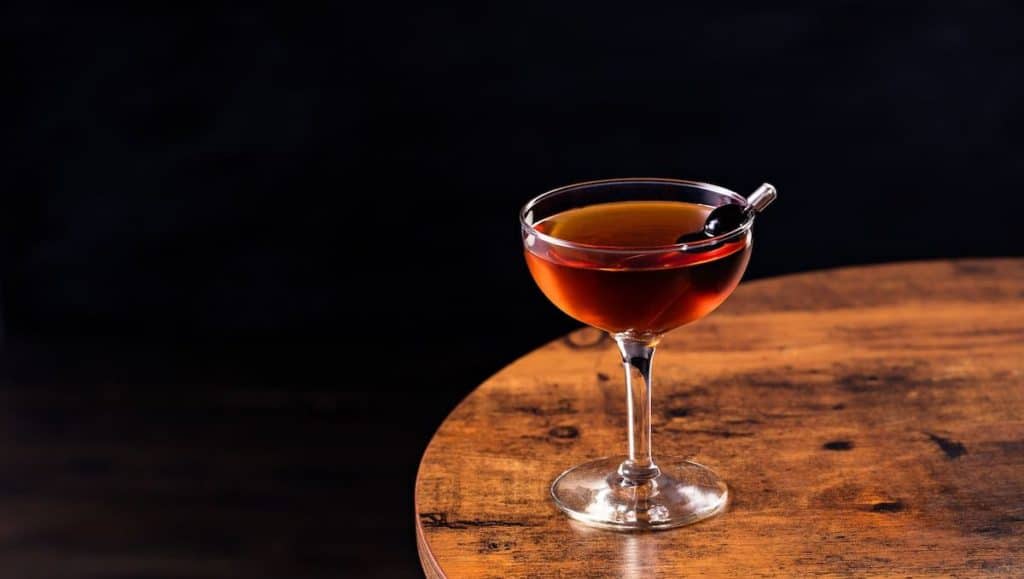
The Manhattan cocktail brought forth relatively few twists and riffs compared to the Old Fashioned. In most cases, you will find recipes that only change minor things. So let me show you how you can tweak the recipe.
Change proportions: Without changing one single ingredient, you can create a totally different cocktail - just by changing the proportions of the ingredients.
For example, when you double the amount of Vermouth, you get a more complex, fruity, and sweet version. Or reduce Vermouth to set more focus on your Whiskey.
Play around, and you can create many variants with very different outcomes.
Exchange cocktail bitters: Cocktail bitters are trending. There are more and more different bitters on the market, so why not try something new.
Try orange or grapefruit bitters instead of Angostura. You will notice a difference for sure.
Use a different vermouth: Vermouth is essential in the Manhattan cocktail. By choosing your vermouth wisely, you can change the result significantly. My recommendation is either Carpano Antica Formula or Cocchi Storico Vermouth di Torino.
Change the base: Rye Whiskey is the traditional base spirit of the Manhattan cocktail, but be brave and try something new.

You can replace it with a good Bourbon or, if you feel experimental, use Cognac or a fine Rum.
The Old Fashioned is probably the cocktail with the most options for riffs. The fact that the simple three-ingredient cocktail primarily showcases the base alcohol makes it easy to invent amazing variations.
You could take a spirit you love and find bitters to match it. There are various delicious Old Fashioned riffs with Rum, Mezcal, or Gin as a base. Other components are also interchangeable. So here's some inspiration:
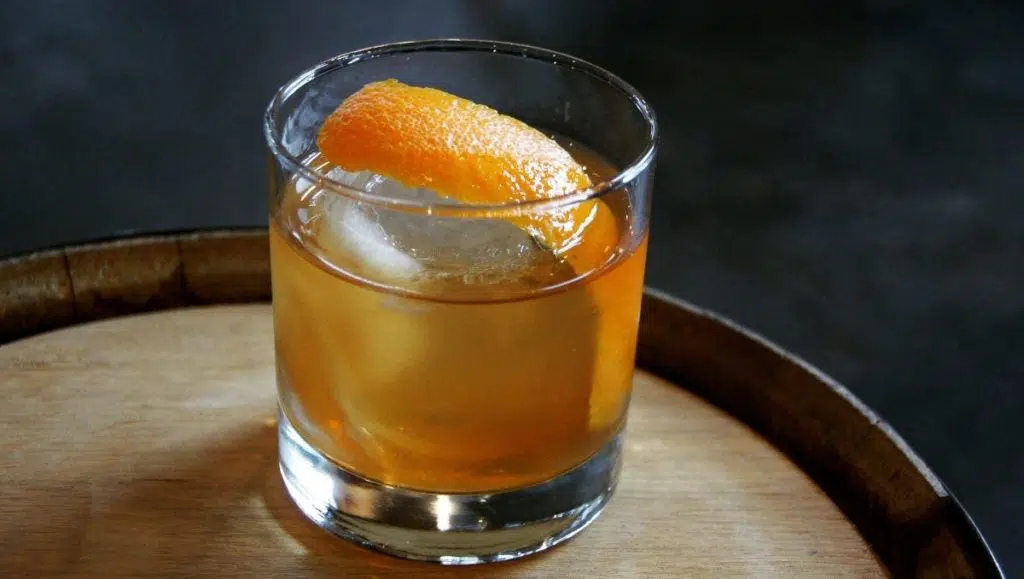
Replace Sweetener: The classic muddled sugar cube often gets replaced with simple syrup. But why not take it further and use some more special syrups?
Try Pineapple syrup for a Rum Old Fashioned, agave syrup for a Mezcal Old Fashioned. Or simply use honey to sweeten the cocktail and create a richer mouthfeel.
Change the base spirit: The easiest and most common way to create an Old Fashioned variation is to change the base element. You can also create a split-based version that is not consisting of one but of two spirits.
For example, you can use 1 part Mezcal and 1 part Tequila as your base. In the classic recipe, this converts to 1oz Tequila and 1oz Mezcal.
Change the bitters: In such a delicate cocktail, exchanging the cocktail bitters will have huge effects. Try chocolate or orange bitters for a start.

Of course, you can also change multiple components at the same time. However, if you're new to mixology, I recommend making one change at a time.
Like that, you can identify what exactly happens if you replace an ingredient and develop a feeling for the process. It helps to figure out what works and what doesn't. If you change everything at once, you might not be able to comprehend the impact of each component.
At first, the differences between the Manhattan and Old Fashioned look marginal. At second glance, however, it becomes clear that the two drinks differ significantly in taste. The reason for this is primarily the sweet vermouth that lends the Manhattan cocktail its full-bodied character.
In conclusion, I can only say that both cocktails have very different flavor profiles. And the best way to discover these differences is to try these drinks for yourself.
The answer to the most important question first: Yes, demerara syrup is different from regular simple syrup. Despite being based on the same formula of 1 part water to 1 part sugar, it brings notably more flavor to your drinks.
That extra kick comes from the nature of the coarse-grained sugar compared to traditional white sugar. Thus, Demerara sugar is not only sweetening your cocktail but adds depth of flavor.
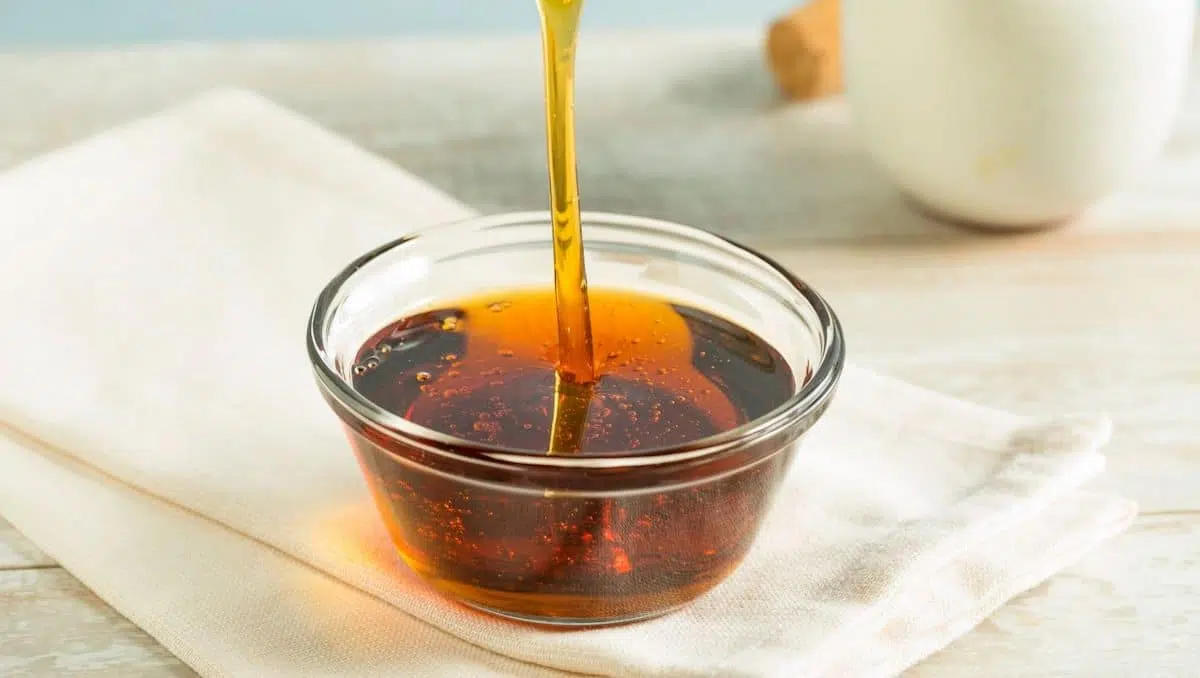
Earthy caramel notes, molasses, and slightly toasty sugar notes work amazingly well with the matching selection of spirits. Regular simple syrup is far more one-dimensional and neutral. - But don't forget: Often, this neutral quality is what we want in cocktails.
Nevertheless, Demerara syrup can lift your cocktails to a new level. Use it in an Old Fashioned Cocktail to see how different the taste can be - just by replacing the sweetening part of your cocktail recipe.
Demerara sugar is a raw, flavorful, unrefined sugar made from sugar cane. It has a crunchy and coarse-grained texture with light brown sugar crystals and results from the first crystallization when processing sugar out of cane juice.
Its origin is in British Guyana, where it ships from the port of Demerara. Hence the name Demerara Sugar.
Since Demerara sugar is less refined, it keeps some of the toffee and caramel notes from molasses. The vicious, dark substance usually is removed when producing refined white sugar, creating that clean sweet taste we're so used to.
Demerara sugar is not easy to get, though. Only a few supermarkets sell it. But you can order it online, for instance on Amazon.
Creating a demerara simple syrup is similar to making regular simple syrup. The ratio is the same: one part sugar and one part water. The most important thing is not to burn the sugar. So add water first and keep stirring while your syrup heats up.
If you want to make a rich demerara syrup, use two parts sugar for one part water and follow the same process.
Also, if you want your syrup to last longer, you can add just a splash of vodka to it.
Demerara is famous for its deep caramel flavor, and so is Demerara syrup. It's a perfect substitute for simple syrup in classic cocktails like the Old Fashioned or the Manhattan Cocktail.
Due to the simplicity of those drinks, you can easily detect the difference the syrup makes. Also, their base spirits pair well with it.
Because the Demerara has these strong toffee and caramel notes, it naturally works well with aged spirits. Whiskey, brandy, or rum cocktails are excellent.
They offer similar aromas, and rum even is made from the same product, sugar cane. That's also why Demerara syrup is often part of Tiki cocktails.
Generally, you can use it as a substitute in any cocktail recipe that includes simple syrup. Yet, I don't think it works with all recipes.
Bringing warm toffee notes into a light summer cocktail with a fruity and floral taste is not my cup of tea. It just won't turn out as good as with a classic simple syrup.
As a rule of thumb: imagine how your cocktail would taste with a hint of caramel. If it feels like a good idea, go for it and try it out.
If you can't get a hand on Demerara, you can, indeed, substitute it. However, there are not many recommendable options. Your best alternative is using Turbinado.
Turbinado is also a less refined sugar made from sugar cane. Though, while Turbinado is coarser than conventional refined sugar types, it is still way finer than Demerara.
It is also less sticky, having almost the same dry, free-flowing character as refined white sugar. Therefore it carries fewer notes of caramel, overall having a lighter flavor.
If you also can't get Turbinado sugar, the last bet is to use brown sugar. Yet, to be perfectly honest with you, the results will be far from what you aim for with a Demerara Syrup.

Horchata is famous all over Latin America. It is a sweet cinnamon drink based on rice. A few years ago, the so-called Dirty Horchata suddenly was trending.
To make it, you need a shot of cold brew or espresso to add to the sweet rice beverage. Served on ice, that is a delicious version of an iced coffee. Add rum and coffee liqueur like Kahlua, and you get a fantastic iced coffee cocktail - a beautiful and low-ABV alternative.
Quick Facts Stone Sour
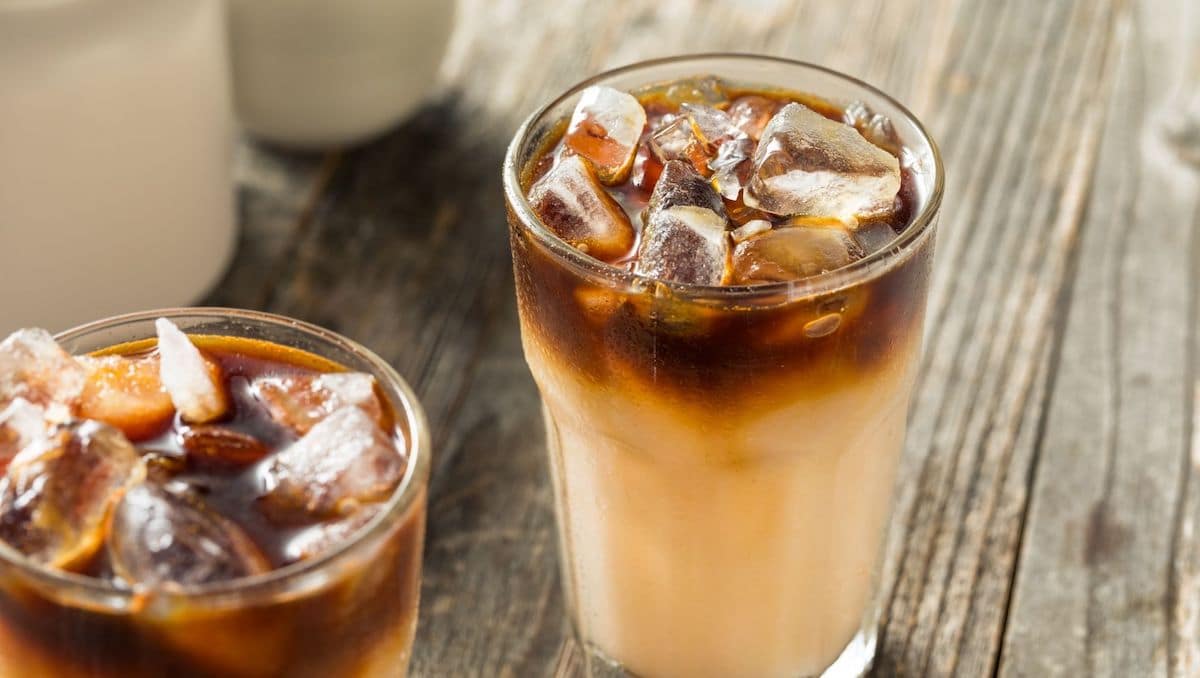
A Horchata is a beverage based on rice, sweetened with condensed milk, and spiced with nutmeg and cinnamon. It has a milky color and consistency and, in its original form, it is alcohol-free.
The beautifully refreshing drink originated in Valencia. Yet there, is it not made with rice but with tiger nuts - a nut that tastes similar to almonds or pecan nuts.
From Spain, the recipe made its way to Latin America. While Horchata is famous throughout Latin America, it seems especially popular in Mexico.
There, it gained vast popularity as an "agua fresca"(translates to "fresh waters"), a typical refreshment drink.
You can find Horchata in supermarkets or order it from online stores - Rice Dream is one of the best-known brands and should be easy to get. Alternatively, you can also make your own.
Making Horchata at home takes a little more time to mix than other refreshments might take, but it is not very complicated and worth the effort. All you need is:
Take a bowl and add 1 cup of rice with 1 1/4 cups of water and let it soak for at least 8 hours at room temperature.
Pour the rice into a blender for a few minutes until it's finely ground. Then, add 1/4 cup condensed milk, 1.5 tsp nutmeg, and 1.5 tsp of cinnamon, and blend again.
Finally, add 4 cups of milk, and voila, your homemade Horchata is ready and set to get dirty.
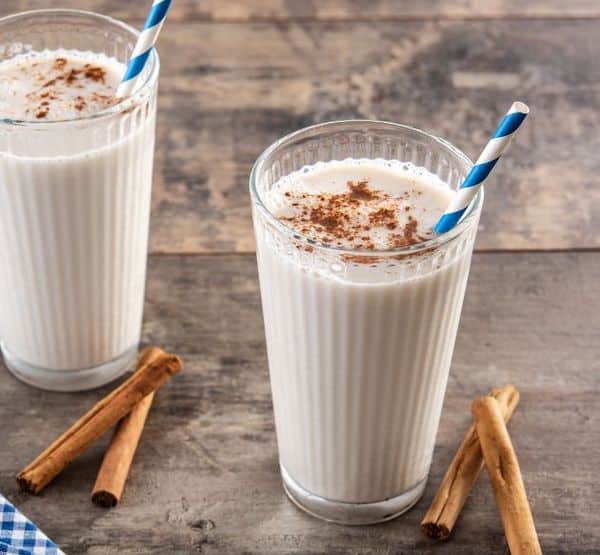
We like to use a combination of Kahlua and dark rum. Half an ounce each is enough and will make for a light drink you can enjoy during the afternoon. If you're not a fan of rum, you can also go for a full oz of Kahlua.
It creates the perfect afternoon caffeine hit with just enough alcohol to make it fun without knocking you out. Having said that, if you serve your Dirty Horchata after dinner and want to increase the ABV, simply double the amount of rum and coffee liqueur.
This summer treat popped up during the last years in coffee shops across the US, from New York to Los Angeles. Initially, it only entailed the addition of cold brew to the refreshment.
The standard way to make a dirty Horchata is by adding coffee. Usually, cold brew, but espresso is also a common option.
Occasionally, you need more than just coffee, and it didn't take long until barkeepers picked up on the concept. So, by adding the right amount of booze, we get an even dirtier version, a double Dirty Horchata Cocktail.
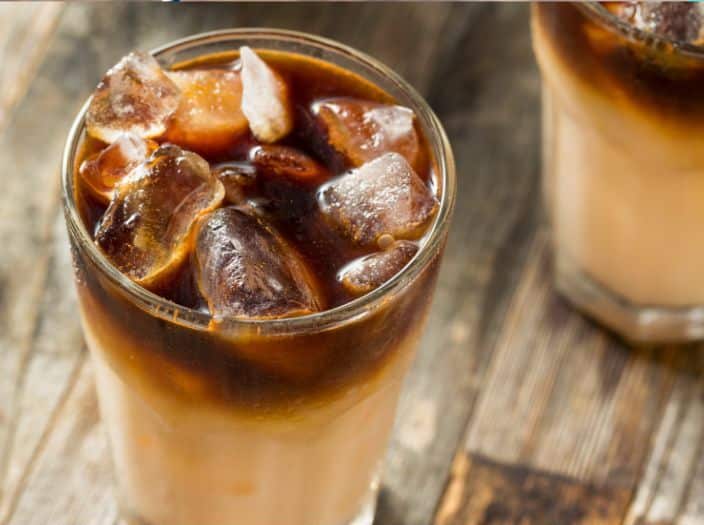
Coffee and cocktails - this combination works, and people love it. If you want to try other recipes, here are some ideas: